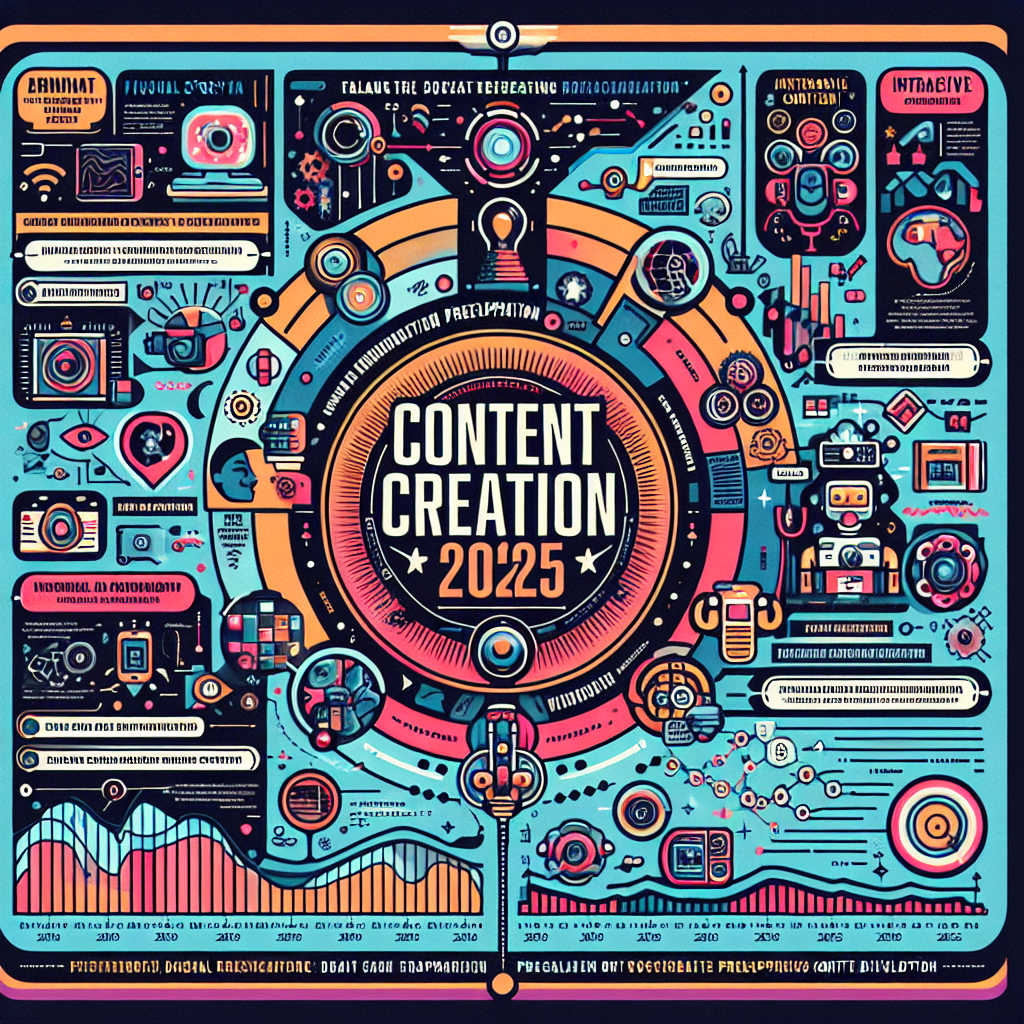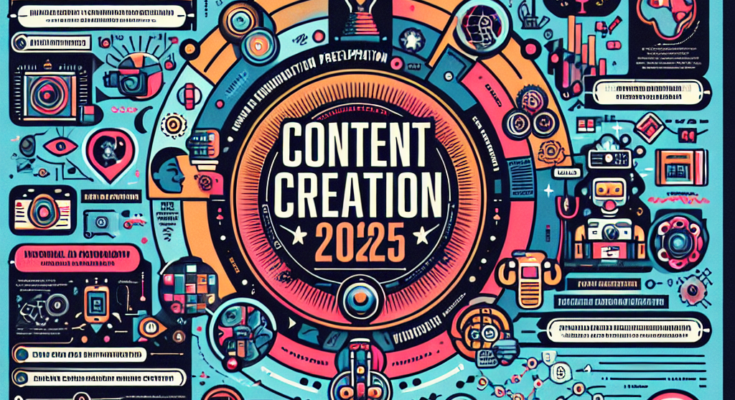Emerging Trends in Content Creation for 2025: What to Expect
As we look ahead to 2025, the landscape of content creation is evolving at an unprecedented pace. With rapid advancements in technology and shifting consumer behaviors, digital marketing strategies must adapt to stay relevant. Content creators are now facing new challenges and opportunities that will shape the future of content. From the rise of AI in content creation to the increasing demand for interactive content, understanding these emerging trends is essential for anyone involved in digital marketing.
Visual storytelling is becoming a key component of successful content strategies. Audiences are drawn to engaging visuals that tell a story, making multimedia content more important than ever. Video marketing strategies are also gaining traction, as platforms like TikTok and Instagram Reels dominate social media evolution. Brands are leveraging these formats to connect with their audience on a deeper level, using brand storytelling techniques that resonate with viewers.
In 2025, user-generated content will continue to play a crucial role in content distribution channels. Consumers trust authentic experiences shared by their peers, making it essential for brands to foster community engagement through influencer marketing. Additionally, podcasts are experiencing significant growth, offering a unique way for brands to reach their audience while providing valuable insights and entertainment.
As content becomes more personalized, data-driven content creation will be key. Marketers will need to utilize SEO strategies tailored for 2025, ensuring that their content ranks well and reaches the right audience. Sustainable content practices will also emerge as a priority, reflecting a growing awareness of environmental impact and ethical considerations in content creation.
The integration of emerging technologies in content will redefine how brands communicate and engage with their audiences. As we embrace these changes, it’s vital to stay informed about the latest trends to ensure success in this dynamic field. Whether it’s enhancing user experience or optimizing for search engines, the future of content creation is bright, and those who adapt will thrive in this ever-evolving landscape.

Understanding the Future of Content Creation
Content creation refers to the process of generating valuable and relevant content for digital platforms. In digital marketing, content creation plays a crucial role in engaging audiences, driving traffic, and enhancing brand visibility. As consumers increasingly seek authentic and informative experiences, the importance of effective content creation continues to rise.
Overview of Current Trends in 2024
- Video Content: Video continues to dominate as users prefer dynamic content over static images or text.
- Personalization: Tailoring content to individual preferences enhances engagement and fosters loyalty.
- AI-Driven Content: Tools using artificial intelligence are helping creators produce high-quality content efficiently.
Purpose of Exploring Emerging Trends for 2025
Investigating emerging trends in content creation for 2025 is essential for marketers and creators alike. Understanding these trends helps in staying ahead of the curve and adapting strategies. By embracing innovations such as augmented reality (AR), interactive storytelling, and enhanced user-generated content, brands can maintain relevance in a rapidly evolving digital landscape. This proactive approach ensures that content remains engaging, impactful, and aligned with audience expectations.
The Rise of Artificial Intelligence in Content Creation
Artificial Intelligence (AI) is revolutionizing content creation in remarkable ways. AI tools are transforming content creation by automating processes that once required extensive human effort. This allows marketers and creators to focus on strategic aspects while AI handles routine tasks.
How AI Tools are Transforming Content Creation
- Automation of repetitive tasks, such as data analysis and content scheduling.
- Generation of personalized content at scale, enhancing audience engagement.
- Real-time feedback and optimization, improving content quality and relevance.
Benefits of Using AI for Marketers and Creators
- Increased efficiency and productivity, allowing for more content to be produced in less time.
- Cost-effective solutions that reduce the need for large teams.
- Enhanced insights through data-driven decision-making, leading to better-targeted campaigns.
Examples of AI-Driven Platforms
| Platform | Functionality |
|---|---|
| ChatGPT | Generates conversational text and assists in content creation. |
| Jasper | Creates marketing copy and blog posts using AI algorithms. |
Ethical Considerations and Challenges in AI Content
While AI offers numerous advantages, it raises ethical issues, including copyright concerns and the potential for misinformation. Ensuring transparency and accountability in AI-generated content is crucial for maintaining trust with audiences.
Engaging Audiences with Interactive Experiences
Interactivity is becoming essential in content engagement for 2025. Engaging audiences through interactive experiences not only captures attention but also enhances retention. When users actively participate, they are more likely to connect with the content on a personal level.
Importance of Interactivity in Content Engagement
Interactive content fosters a two-way communication channel, making users feel valued. This engagement can significantly increase time spent on a site and improve conversion rates. Furthermore, it helps create memorable experiences that encourage sharing and returning visits.
Types of Interactive Content
- Quizzes: Fun and informative, quizzes allow users to test their knowledge while providing personalized results.
- Polls: Quick and effective, polls invite audience opinions, generating real-time feedback.
- AR/VR Experiences: Immersive technologies transport users into new environments, making learning and exploration dynamic.
Case Studies of Successful Interactive Content Campaigns
| Campaign | Type | Outcome |
|---|---|---|
| BuzzFeed Quizzes | Quizzes | High share rates and increased site traffic. |
| Spotify Wrapped | Personalized Data | Enhanced user engagement and social media buzz. |
| IKEA Place App | AR Experience | Boosted sales through immersive shopping experiences. |
Tools for Creating Immersive Content
Several tools can help in creating engaging interactive content:
- Typeform: For creating beautiful quizzes and surveys.
- Unity: A platform for developing AR and VR applications.
- Poll Everywhere: For live polls and audience interaction during events.
By leveraging these strategies and tools, brands can captivate their audiences and drive meaningful engagement through interactive experiences.
The Continued Growth of Video as a Primary Content Medium
Video consumption continues to soar, with statistics showing that 82% of all internet traffic will come from video by 2025. This remarkable rise highlights the importance of video as a primary content medium.
Short-Form vs Long-Form Video Content
Both short-form and long-form videos play crucial roles in audience engagement. Short-form videos, like those on TikTok and Instagram Reels, cater to audiences seeking quick, entertaining content. In contrast, long-form videos, often found on YouTube, provide in-depth information and storytelling, appealing to viewers looking for comprehensive insights.
The Role of Live Streaming in Audience Engagement
Live streaming has emerged as a powerful tool for audience interaction. Platforms such as Facebook Live and Twitch allow creators to connect with their viewers in real-time, fostering community and engagement. This immediacy helps maintain viewer interest and build loyalty.
Platforms to Watch
- YouTube: Dominating long-form video, YouTube remains a leader in content creation.
- TikTok: Known for its viral short videos, TikTok attracts younger audiences.
- Instagram Reels: This feature enhances Instagram’s appeal with short, engaging clips.
As video continues to grow as a leading content medium, understanding these trends is essential for creators aiming to capture audience attention effectively.
Tailoring Content to Individual Preferences
Understanding Audience Segmentation and Targeting
Effective content creation requires a deep understanding of audience segmentation. By dividing audiences into specific groups based on demographics, interests, and behavior, creators can tailor content that resonates with each segment. This targeted approach enhances engagement and drives conversions.
The Role of Data Analytics in Personalization
Data analytics plays a crucial role in personalizing content. By analyzing user data, including browsing history and interaction patterns, brands can craft experiences that cater to individual preferences. This data-driven strategy allows for dynamic content adjustments, ensuring relevance and timeliness.
Examples of Personalized Content Strategies
- Email Marketing: Customized email campaigns based on user behavior and past purchases.
- Dynamic Web Content: Websites that change content based on visitor profiles.
- Social Media Ads: Targeted advertisements that reflect users’ interests and online behavior.
Challenges in Implementing Effective Personalization
Despite its benefits, implementing effective personalization comes with challenges. Privacy concerns and data security regulations can limit data collection efforts. Additionally, ensuring the right balance between personalization and user autonomy is essential to avoid overwhelming users with tailored content.
Creating Content with Environmental Responsibility
The growing demand for sustainable practices in content creation is reshaping the industry. Brands are increasingly recognizing the importance of environmental responsibility, which influences their content strategies. This shift not only meets consumer expectations but also aligns with global sustainability goals.
Examples of Eco-Friendly Content Initiatives
- Digital-Only Campaigns: Brands like Coca-Cola have shifted to digital platforms, reducing paper waste significantly.
- Green Partnerships: Collaborations with environmental organizations, such as Adidas partnering with Parley for the Oceans, highlight commitment to sustainability.
- Eco-Conscious Messaging: Campaigns that focus on eco-friendly products encourage consumers to make greener choices.
How Brands Can Communicate Their Sustainability Efforts
Brands can effectively communicate their sustainability efforts through transparent storytelling, sharing impactful data on their eco-friendly practices, and utilizing social media platforms to engage audiences. Highlighting specific actions, such as reducing carbon footprints or using recycled materials, builds trust.
The Impact of Sustainability on Consumer Behavior
As consumers become more environmentally conscious, their purchasing decisions are influenced by brands that prioritize sustainability. Studies show that 73% of millennials are willing to pay more for sustainable products. This trend indicates that integrating environmental responsibility into content is essential for brand loyalty and growth.
The Shift Towards Voice and Audio Formats
As we move into 2025, the shift towards voice and audio formats is becoming increasingly prominent. Statistics reveal that over 55% of households are expected to own a smart speaker by 2025, highlighting the growth of voice search usage. This trend emphasizes the need for content creators to adapt their strategies accordingly.
Statistics on Voice Search Usage and Growth
- Over 50% of all searches are voice searches.
- Voice commerce is projected to reach $40 billion by 2025.
- Approximately 70% of voice search users are looking for instant answers.
Strategies for Optimizing Content for Voice Search
- Use conversational language to align with natural speech patterns.
- Focus on long-tail keywords that match how people speak.
- Optimize for local SEO, as many voice queries are location-based.
The Rise of Podcasts and Audio Storytelling
Podcasts have exploded in popularity, with over 100 million Americans tuning in regularly. Audio storytelling captivates audiences, making it a powerful tool for brands to engage listeners effectively.
Tools for Creating Audio Content Efficiently
| Tool | Description |
|---|---|
| Audacity | A free, open-source audio editing software. |
| Anchor | An easy-to-use platform for podcast creation and distribution. |
| Descript | A tool that allows editing audio by editing text. |
Embracing these trends in voice and audio formats will be crucial for content creators aiming to stay relevant and connected with their audience in the coming years.
Leveraging User-Generated Content and Community Engagement
Community plays a crucial role in shaping an effective content strategy. By engaging with the audience, brands can foster deeper connections and enhance their content’s relevance. This engagement encourages users to share their experiences, leading to valuable user-generated content (UGC).
The Importance of Community in Content Strategy
Building a community around a brand creates a sense of belonging. When users feel connected, they are more likely to contribute content that resonates with others. This not only enriches the brand’s narrative but also aligns closely with customer interests.
How to Encourage User-Generated Content
- Run contests and challenges that invite users to share their content.
- Create hashtags that encourage participation on social media platforms.
- Offer incentives such as discounts or recognition for featured contributions.
Showcasing Community Stories and Experiences
Highlighting community stories is vital. Brands can feature user testimonials, success stories, and creative contributions, creating relatable content that fosters trust. This showcases the diversity of the community and strengthens brand loyalty.
Benefits of Building a Loyal Audience Through Community
A loyal audience leads to increased engagement, better retention rates, and organic growth. By prioritizing community engagement, brands can leverage UGC to amplify their message while building a genuine connection with their audience.
Adapting to the Decreasing Attention Span of Audiences
In today’s fast-paced digital world, understanding the psychology behind short attention spans is essential for content creators. Research indicates that the average human attention span has decreased, making it crucial to adapt strategies accordingly.
What is Snackable Content and Its Formats?
Snackable content refers to bite-sized pieces of information that are easy to consume quickly. Common formats include:
- Short videos (under 60 seconds)
- Infographics
- Listicles
- Social media posts
Strategies for Creating Concise and Engaging Content
To effectively engage audiences with shorter attention spans, consider these strategies:
- Use clear and straightforward language.
- Break content into smaller sections with headings.
- Incorporate questions to prompt interaction.
The Role of Visuals and Headlines in Capturing Attention
Visuals and compelling headlines play a vital role in capturing attention. Eye-catching images, bold fonts, and intriguing headlines can draw readers in and encourage them to explore content further. Additionally, visuals enhance retention, making the information more memorable.
By focusing on snackable content and employing effective strategies, creators can successfully adapt to the decreasing attention span of audiences, ensuring their messages resonate in an ever-evolving digital landscape.
Preparing for the Future of Content Creation
Recap of Key Trends for 2025
- AI Integration: The use of artificial intelligence in content creation will streamline processes and enhance personalization.
- Interactive Content: Expect more quizzes, polls, and games that engage users actively.
- Video Dominance: Short-form videos will continue to rise, capturing attention across platforms.
- Sustainability Focus: Brands will prioritize eco-friendly content strategies that resonate with conscious consumers.
Encouragement for Marketers and Creators to Adapt
Marketers and creators must embrace these trends to stay relevant. Adapting to new technologies and consumer preferences is essential. By leveraging AI tools, creating interactive experiences, and focusing on video content, professionals can connect with audiences more effectively. Staying flexible and innovative will ensure success in this evolving landscape.
Final Thoughts on the Evolution of Content Creation
The landscape of content creation is changing rapidly. Understanding these key trends is crucial for future success. As content becomes more dynamic and user-focused, creators must remain agile and ready to pivot strategies. The evolution of content creation not only presents challenges but also exciting opportunities for growth and engagement.
Conclusion
As we look ahead to 2025, the landscape of content creation is set to evolve dramatically. Understanding the future of content creation means embracing the rise of artificial intelligence, which will streamline production and enhance creativity. Engaging audiences through interactive experiences will become essential, as will the continued dominance of video. Tailoring content to individual preferences and creating with environmental responsibility are critical trends that will shape consumer expectations. Additionally, the shift towards voice and audio formats, along with leveraging user-generated content, signifies a community-centric approach. Adapting to shorter attention spans is vital for success in this dynamic digital world.



